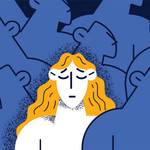Saved by shock therapy
One woman shares her struggle with a sudden mental illness and how shock therapy saved her life

Source: Best Health Magazine, November/December 2010
It is difficult to picture Tamsin Atherton as a patient in the locked ward of a mental health hospital. The Toronto speech pathologist, 42, is a calm, capable and gregarious woman who has a thriving career and a caring partner. Two adoring dogs trail behind her as she moves about her airy white kitchen, preparing a pot of chocolate chai tea while she considers how to tell her story.
It is, she says, precisely because she didn’t see it coming, couldn’t picture it herself, that she came to us to offer other women this cautionary tale. Because over the course of several months in 2007 and 2008, Tamsin changed from a confident person who was newly in love, to a woman so depressed that she could barely speak, and was rapidly losing her will to live. Had she not responded to electroconvulsive therapy (ECT’known in an earlier era as shock therapy), she might not be here, so cheerfully offering tea.
More than just the blues
In retrospect, she thinks that the seeds of depression began in January 2007, when she experienced an intense bout of the flu. Although she recovered, she never properly regained her appetite. Interestingly, experts say there may be a correlation between viral illness (such as the flu) and depression, since they generate similar symptoms, including fatigue, poor appetite and high emotion. Whatever the case might be, Tamsin also happened to be facing a whirlwind of changes in her life. Within weeks of her flu, Tamsin, who had grown up on a hobby farm near Kingston, Ont., had ended a relationship and shortly afterwards, met her current partner (who did not want to be named in this story). Then she moved offices, and also underwent a lot of work-related changes. In the autumn of 2007, the couple bought a house together with a basement office where Tamsin could meet with the kids who are her speech pathology clients.
These were positive changes, yet Tamsin noticed that she was losing weight and beginning to feel somehow off-kilter. ‘I just started not feeling like myself anymore,’ she recalls. ‘I generally have joie de vivre. I like my work and I’m a sociable, friendly person.’ In November, her strange feelings of ennui took on an edge of anxiety, something she was also unfamiliar with. ‘What if I don’t get things done in time?’ she would fret to herself. ‘What if I don’t get things right?’ This sense of losing her nerve became more pronounced week by week. Not only was she feeling less confident, but soon the ‘what ifs?’ were more akin to ‘look what you’ve done!’
Such feelings of worthlessness are a hallmark of depression, but Tamsin wasn’t aware of that. To borrow a phrase from psychology, she believed what she thought, and she didn’t connect it to an illness. ‘One day, my partner came home with flowers for me and I just wanted to cry. I felt like I had let everybody down.’ By early spring 2008, Tamsin had developed acute insomnia, and could no longer concentrate enough to read.
Although Tamsin didn’t open up to her friends, she did begin searching for help. Counselling didn’t achieve anything; neither did homeopathic calming remedies. In May of that year, her GP prescribed an antidepressant, some sleeping pills and a week off work. But, by June, Tamsin could no longer work at all. ‘I could not get away from my brain,’ she says, referring to the circular and racing thoughts that characterize acute anxiety and depression. ‘I felt like a burden to everyone.’
When depression takes a bad turn
During that summer of 2008, just over a year since she started feeling different, Tamsin entered into what is known as psychotic depression. Her thoughts detached from reality. ‘I grew convinced that I was going to be homeless,’ she says, by way of example. ‘I thought I was going to be taken to jail. I thought my partner was somehow going to swindle me.’ Psychotic depression is rare. According to Dr. Roger McIntyre, head of the Mood Disorders Pharmacology Unit at Toronto Western Hospital, depression affects about 10 to 15 percent of people at some time in their lives. ‘About 20 percent of individuals with depression will exhibit psychotic symptoms,’ he says, although a precise prevalence rate is difficult to estimate.
The risk is higher, McIntyre says, in the elderly and in adolescents‘perhaps because of the way their brains are changing. It is also more common in bipolar disorder (where a person cycles between depressive lows and manic highs) than in unipolar depression. Why it happened to Tamsin is a mystery. Medical historian Edward Shorter of the University of Toronto points out that psychotic depression has been known to have such biological triggers as high cortisol, insomnia and starvation, all of which could have been at play in this instance.
‘In the psychotic variety of depression,’ Shorter notes, ‘patients may have a hint of mania, exhibiting such features of agitation as pacing, and repeating ‘it’s my fault, it’s my fault.”’ Unlike depression caused by life circumstances’for example, grief or the loss of a job’psychotic depression is ‘autonomous,’ adds Shorter. ‘It does not get better with good news. Your lover has just moved in? Guess what, your psychotic depression has not improved.’
On Labour Day weekend, her partner took Tamsin to Psychiatric Emergency at Toronto’s Centre for Addiction and Mental Health (CAMH). She was admitted to a ward, where she was given a heavy amount of medication’antidepressants and antipsychotics. They ‘numbed’ her, as she puts it now, but failed to lift her mood. So her attending psychiatrist broached the subject of ECT.
Shock therapy then and now
While the treatment has been in use since the Italian psychiatrist Ugo Cerletti pioneered it in 1938, ECT continues to conjure images of psychiatric brutality, mainly from such ’70s-era movies as One Flew Over the Cuckoo’s Nest. The sight of a patient being administered electric shock treatments and then flailing and convulsing on a table isn’t pretty. In reality, though, ECT is a more benign experience these days, and is practised throughout Canada on some severely depressed patients who haven’t responded to other treatments.
Patients are given a muscle relaxant and put under general anesthetic before the procedure takes place. Once they are asleep, two electrodes are placed on their scalps, and controlled bursts of electric current are applied, which induces a seizure. (Some medical practitioners have characterized the effect as being similar to pressing a reset button, or rebooting a computer.) The patient awakens within 10 or so minutes, and the whole thing is repeated a couple of days later. On average, a patient gets 12 sessions over four weeks. At CAMH, about 200 patients receive ECT every year.
Psychiatrists still don’t know why ECT works, and the procedure is not without risk. ‘There is permanent loss of memory to some degree,’ explains Dr. Barry Martin, former head of the ECT service at CAMH. ‘Recall is patchy for the period immediately before and during the treatments.’ However, the loss of the ability to learn and retain new information isn’t permanent. ECT was long considered a treatment of last resort, partly due to the stigma, but that view is beginning to change. ‘The response rates to antidepressant medications are in the order of 60 percent,’ says Martin, but once remission rates are taken into account, that figure is closer to 40 percent. For severely depressed patients who may be at risk of suicide, the question being asked by Canadian psychiatrists, says Martin, is whether ECT should actually be the first-line treatment for some of those patients. ‘Meaning, don’t wait for the antidepressants to fail.’
The benefit of shock therapy
Tamsin agreed to the ECT, but with almost hopeless indifference. She had no expectation that it would help. On the morning of Oct. 27, 2008, she had her first treatment session. That afternoon, she was out on leave from the hospital, walking in a park, and realized with some astonishment that she was enjoying herself. It was the first time in over a year that she had enjoyed her customary walk. To her partner’s astonishment, Tamsin suggested that they find some pumpkins to carve for Halloween. ‘It was almost like a miracle,’ her partner says. ‘Tamsin was totally herself.’ As if the electric shocks had somehow snapped her out of a stupor.
‘The cases where we see a dramatic response,’ says Martin, ‘are those patients who have psychotic depression with catatonic features.’ This would fairly describe Tamsin, who was essentially no longer even speaking. ‘For some reason, they respond the best to the treatment. Why would the most severe illnesses respond? We don’t know. It’s interesting.’
ECT doesn’t always work for everyone as swiftly as it did for Tamsin, who was back to being her old self completely after the first three sessions. (She continued with the full regimen of ECT treatment, just to be sure, returning to CAMH as an outpatient once each month until May 2009.) But she was actually able to resume her work by mid-December 2008, and has been flourishing ever since.
Tamsin waited for a year before she was confident enough in her recovery to talk about her experience with readers of Best Health. ‘I had to be sure I was absolutely back to normal. ECT saved my life.‘ She hopes that sharing her story will provide another woman, who may be struggling as she was, with a sense of light at the end of the tunnel.
This article was originally titled ‘Saved by shock therapy,’ in the November/December 2010 issue of Best Health. Subscribe to Best Health today and never miss an issue!




